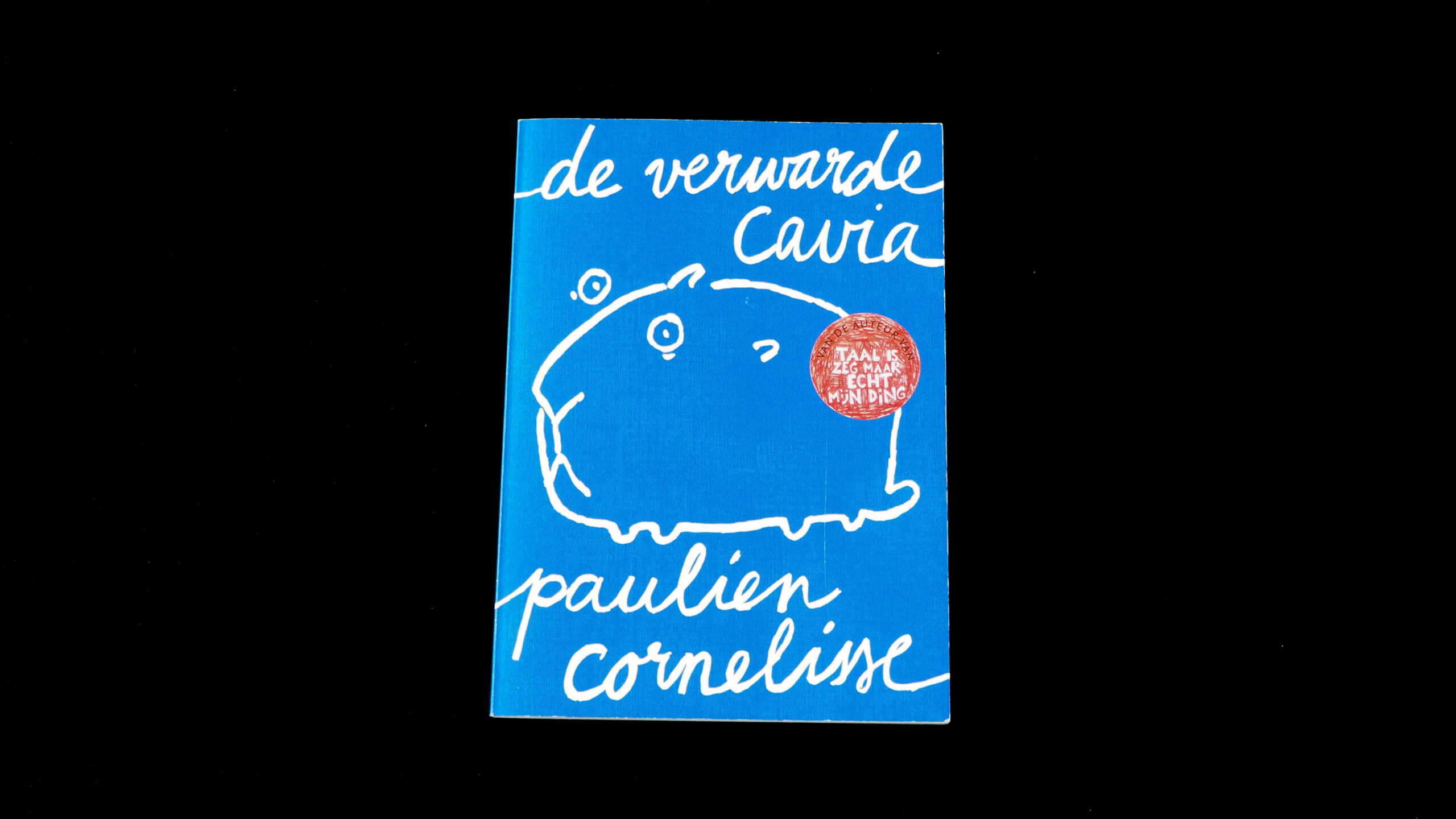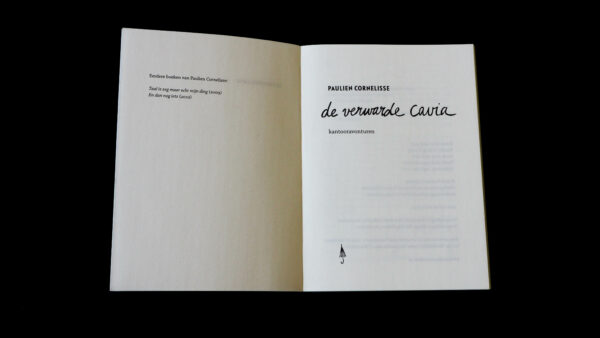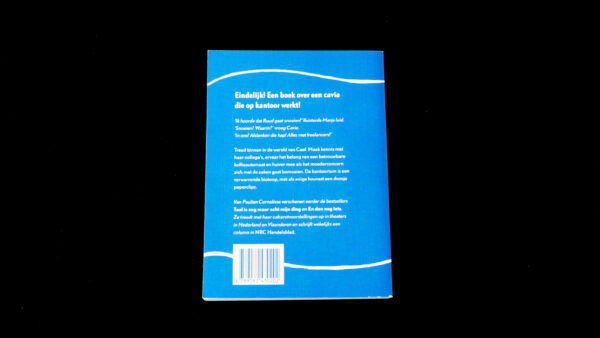De Verwarde Cavia
De Verwarde Cavia
In order to sell a printed novel in an age where digital is cheaper, many publishers resort to the obvious clichés: textile hardcovers, golden letters, shiny dust covers, about twenty Pantone colours and overly-crafted typefaces. To justify a sale, the trick seems to make people think they can buy a luxury experience that digital books simply cannot offer. As if dressed up in their Sunday suits to appear better than they actually are I want to yell out the same line as the observant child in The Emperor’s New Clothes: ‘But he isn’t wearing anything at all!’ Paulien Cornelisse’s De Verwarde Cavia was this year’s only exception.
In addition to its form, the book constitutes a series of smart observations and bold choices. De verwarde cavia is a reflection of that. Form follows and in the case of this book it follows the wet dream of every designer: authorship. With her book, Cornelisse has appropriated every decision in order to make a statement to publishers, without resorting to the clichés of self-publishing, like print-on-demand, design-it-yourself or obvious visual languages. A result of how flexible you can be in a commercial environment that is changing so rapidly. The jury received this book with mixed feelings and we expect this reaction might be felt by many who encounter it in the setting of The Best Dutch Book Designs.
Leading up to the final result Cornelisse light-heartedly introduced her audience to the process of making her book using social media, creating very peculiar meme-like images, weird T-shirts give-a-ways, and cheesy messages. Nearly everything about this process refers to the surrounding space of the book as an object, the author as a person, the publisher as an obstruction and the reader as an audience. Aware of all these networks, De Verwarde Cavia is an object come to fruition by exercising uncompromised authorship; the result of the right attitude at the right moment.
Typographically it could be more interesting and precise. But with over 100,000 copies sold this book proves that you don’t need fancification to be read.
- Auteur
- Paulien Cornelisse
- Oplage
- 100,000
- Omvang
- 185
- Prijs
- 14.99 euro
- ISBN
- 9789082430202
- Verschijningsdatum
- April 2016
- Uitgever / Opdrachtgever
- Paulien Cornelisse, Amsterdam
- Ontwerper(s)
- Paulien Cornelisse, Sander Pinkse, Amsterdam.
- Drukkerij
- Wöhrmann, Zutphen
- DTP / Zetterij
- Sander Pinkse
- Boekbinderij
- Wöhrmann, Zutphen
- Materiaal
- Interior: 90 g/m² houtvrij roman creme (Munken). Cover: 280 g/m² F color leinen, karton met linnenpersing en een mat persvernis (Gebr. Schabert).
- Lettertype
- Chaparelle, Nobel, zelf getekende letters
- Technische Bijzonderheden
- Om het intense blauw van het omslag te krijgen (een pms kleur, dus geen 'opgebouwde kleur'), is er dubbel gedrukt. Ook omdat juist blauw gevoelig is voor het onstaan van zg spanjolen. - voor het buigzame gevoel van de rug is koudlijm gebruikt, in plaats van het meer gangbare hotglue of twinflex
Voor de letters op het omslag is bewust voor Nobel gekozen, omdat die letter niet alleen mooi is, maar ook in Amsterdam ontworpen, net als de auteur van het boek.
Er is bewust gekozen voor een softcover, om het gevoel op te roepen van een poeziebundel uit de jaren tachtig: "Nu hoor je het eens van een ander".
Anders dan bij andere uitgeverijen zit achter zowel tekst als uitvoering van het boek dezelfde persoon, namelijk Paulien Cornelisse.
Ook al is dit een boek dat een grote groep mensen heeft bereikt, het is in opzet en uitvoering volstrekt compromisloos geweest. Geen flappen om het er duurder uit te laten zien. Geen overbodig leeslintje. Wel een zeer gedetailleerd idee over welke kleur het boek moest hebben, en in welke intensiteit. Ook een compromisloze, zelfgetekende voorkant. Zodat dit boek niet lijkt op andere boeken.
In order to sell a printed novel in an age where digital is cheaper, many publishers resort to the obvious clichés: textile hardcovers, golden letters, shiny dust covers, about twenty Pantone colours and overly-crafted typefaces. To justify a sale, the trick seems to make people think they can buy a luxury experience that digital books simply cannot offer. As if dressed up in their Sunday suits to appear better than they actually are I want to yell out the same line as the observant child in The Emperor’s New Clothes: ‘But he isn’t wearing anything at all!’ Paulien Cornelisse’s De Verwarde Cavia was this year’s only exception.
In addition to its form, the book constitutes a series of smart observations and bold choices. De verwarde cavia is a reflection of that. Form follows and in the case of this book it follows the wet dream of every designer: authorship. With her book, Cornelisse has appropriated every decision in order to make a statement to publishers, without resorting to the clichés of self-publishing, like print-on-demand, design-it-yourself or obvious visual languages. A result of how flexible you can be in a commercial environment that is changing so rapidly. The jury received this book with mixed feelings and we expect this reaction might be felt by many who encounter it in the setting of The Best Dutch Book Designs.
Leading up to the final result Cornelisse light-heartedly introduced her audience to the process of making her book using social media, creating very peculiar meme-like images, weird T-shirts give-a-ways, and cheesy messages. Nearly everything about this process refers to the surrounding space of the book as an object, the author as a person, the publisher as an obstruction and the reader as an audience. Aware of all these networks, De Verwarde Cavia is an object come to fruition by exercising uncompromised authorship; the result of the right attitude at the right moment.
Typographically it could be more interesting and precise. But with over 100,000 copies sold this book proves that you don’t need fancification to be read.
- Auteur
- Paulien Cornelisse
- Oplage
- 100,000
- Omvang
- 185
- Prijs
- 14.99 euro
- ISBN
- 9789082430202
- Verschijningsdatum
- April 2016
- Uitgever / Opdrachtgever
- Paulien Cornelisse, Amsterdam
- Ontwerper(s)
- Paulien Cornelisse, Sander Pinkse, Amsterdam.
- Drukkerij
- Wöhrmann, Zutphen
- DTP / Zetterij
- Sander Pinkse
- Boekbinderij
- Wöhrmann, Zutphen
- Materiaal
- Interior: 90 g/m² houtvrij roman creme (Munken). Cover: 280 g/m² F color leinen, karton met linnenpersing en een mat persvernis (Gebr. Schabert).
- Lettertype
- Chaparelle, Nobel, zelf getekende letters
- Technische Bijzonderheden
- Om het intense blauw van het omslag te krijgen (een pms kleur, dus geen 'opgebouwde kleur'), is er dubbel gedrukt. Ook omdat juist blauw gevoelig is voor het onstaan van zg spanjolen. - voor het buigzame gevoel van de rug is koudlijm gebruikt, in plaats van het meer gangbare hotglue of twinflex
Voor de letters op het omslag is bewust voor Nobel gekozen, omdat die letter niet alleen mooi is, maar ook in Amsterdam ontworpen, net als de auteur van het boek.
Er is bewust gekozen voor een softcover, om het gevoel op te roepen van een poeziebundel uit de jaren tachtig: "Nu hoor je het eens van een ander".
Anders dan bij andere uitgeverijen zit achter zowel tekst als uitvoering van het boek dezelfde persoon, namelijk Paulien Cornelisse.
Ook al is dit een boek dat een grote groep mensen heeft bereikt, het is in opzet en uitvoering volstrekt compromisloos geweest. Geen flappen om het er duurder uit te laten zien. Geen overbodig leeslintje. Wel een zeer gedetailleerd idee over welke kleur het boek moest hebben, en in welke intensiteit. Ook een compromisloze, zelfgetekende voorkant. Zodat dit boek niet lijkt op andere boeken.




